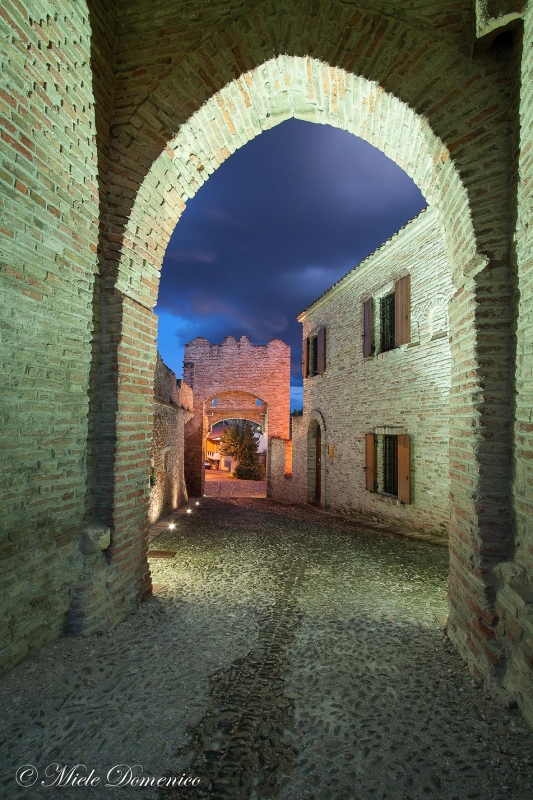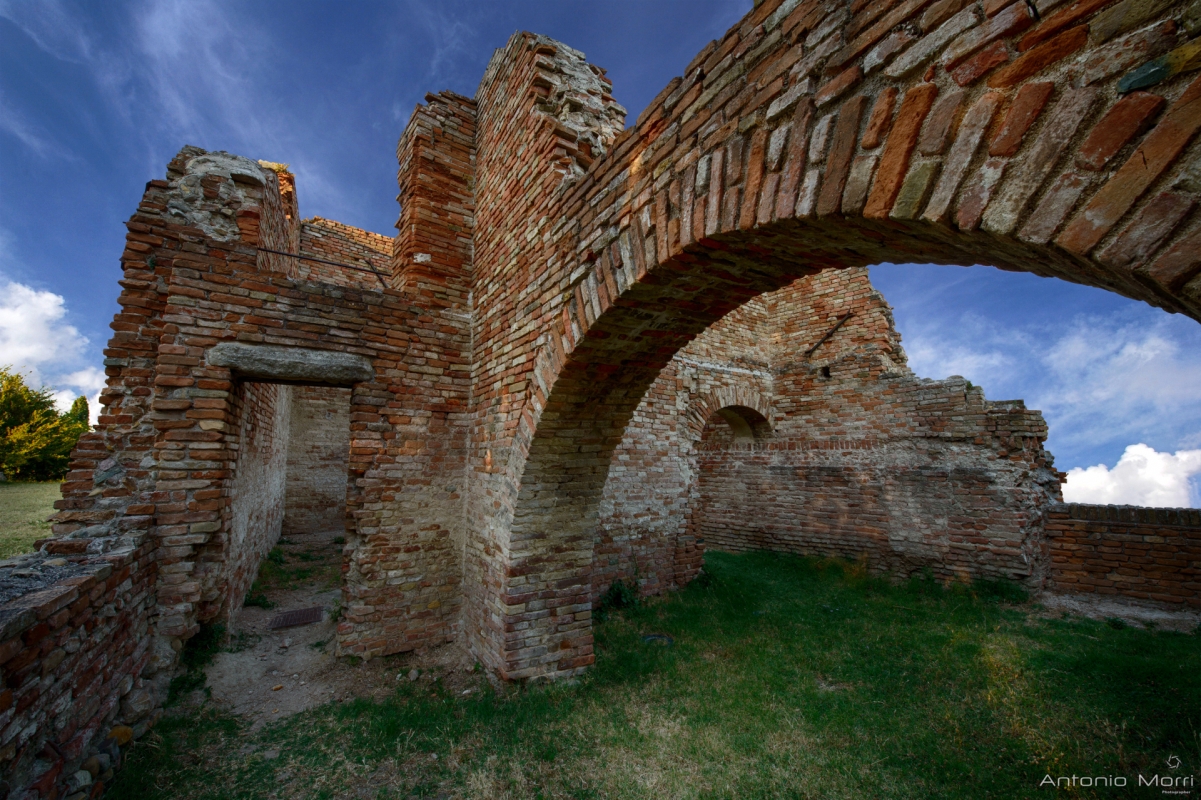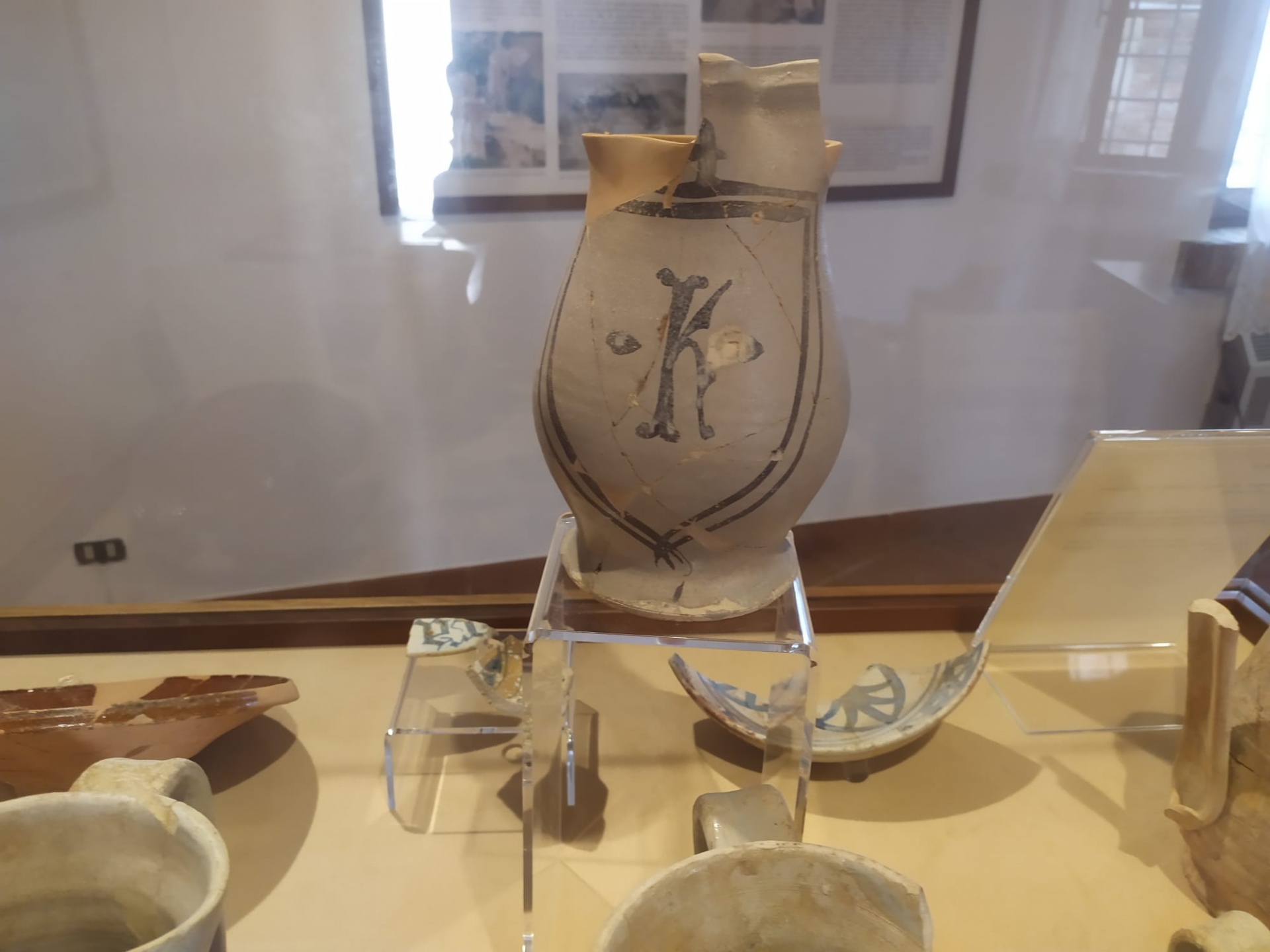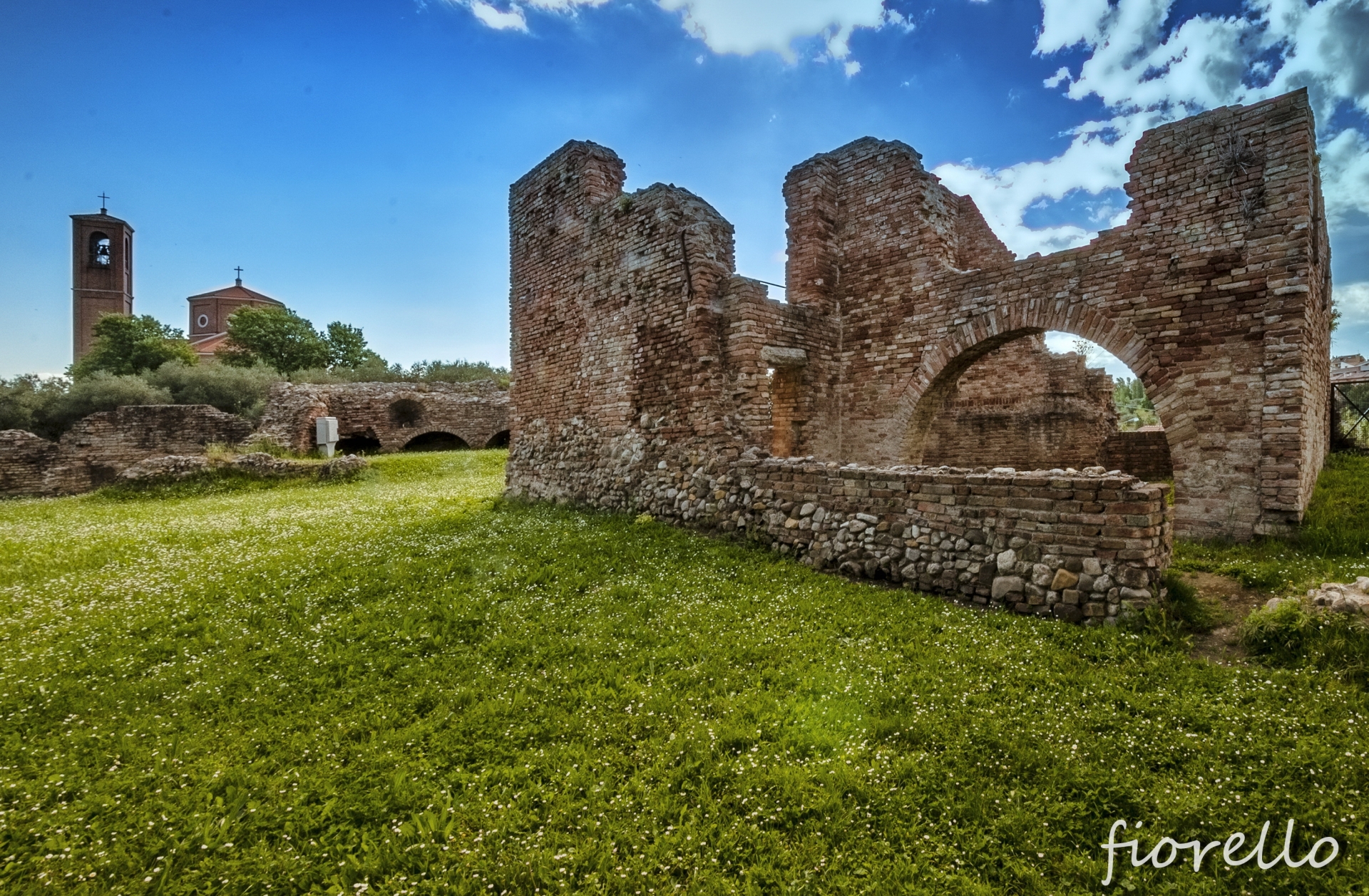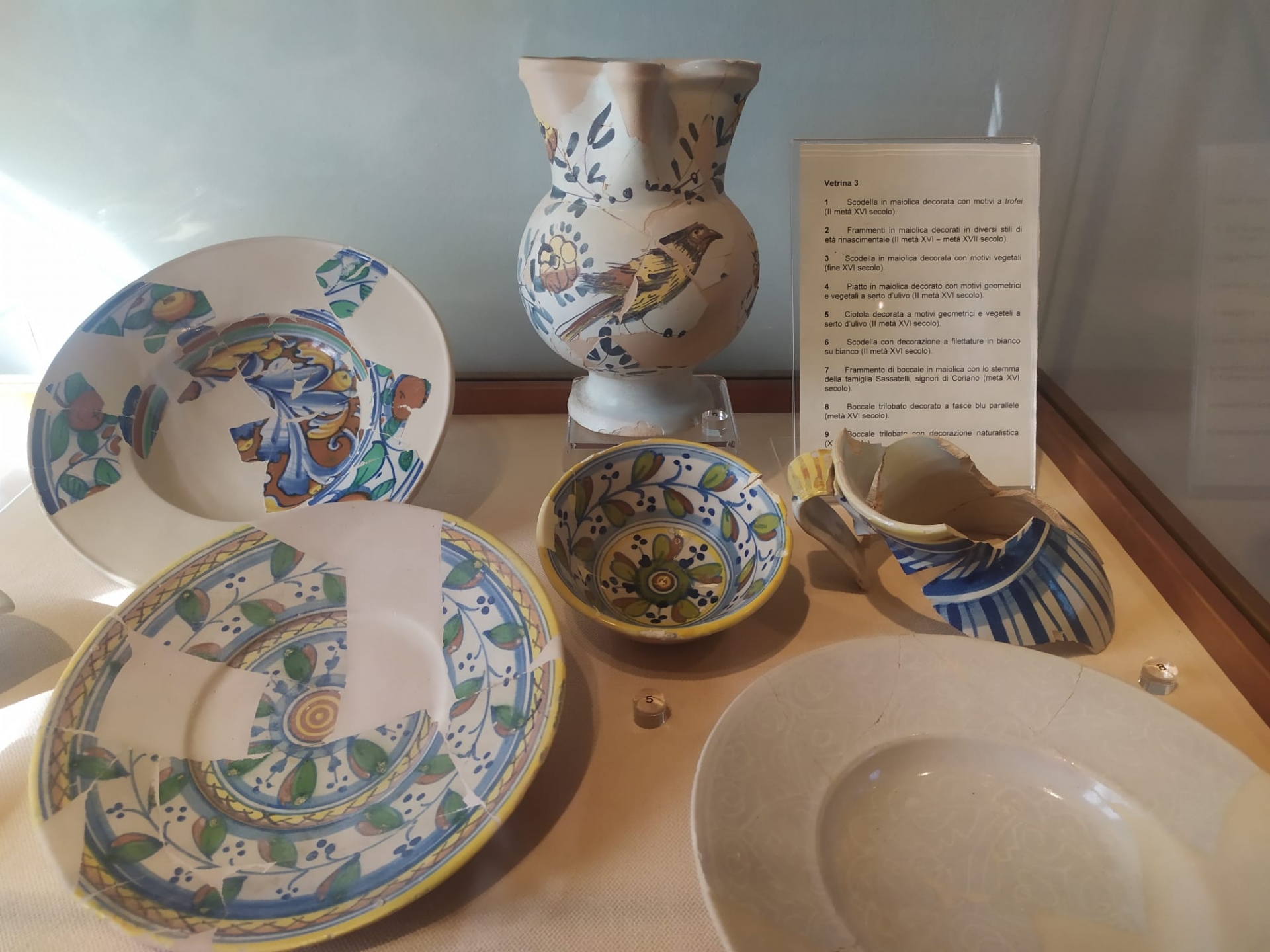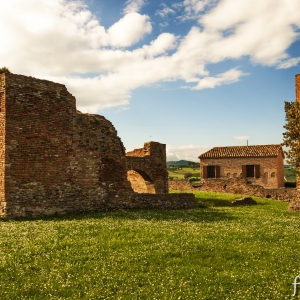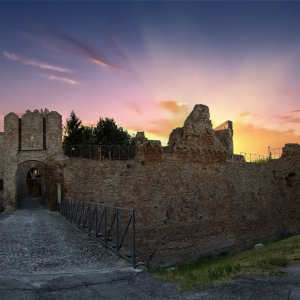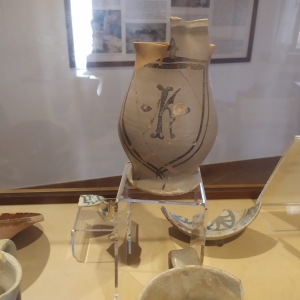Malatesta Castle of Coriano
Coriano with its fortification stands in an isolated place. Coriano was a fortified centre documented as early as the end of the 12th century, endowed with its own magistracy, with a large territory, located on a slight hill (102 metres above sea level), from which it is still possible to enjoy the view of its vast and delightful panorama immersed in the nature of the Romagna hinterland.
The castle or castrum is a rather unusual
fortification; in fact, it is not a fortress built for the exclusive military or residential use of a single lord, nor is it the size of a fortified village. The layout of the castle, whose imposing ruins remain on a natural elevation, is outside the modern town centre.
Today, an important gate tower survives, already equipped with a drawbridge and surmounted by a quadrangular tower with a coat of arms and traces of corbels and battlements on the top. Still visible are a first and second section of wall, forming part of an irregular polygonal wall, and a second gate with a pointed arch. In
Coriano, during the restoration of the castle, one of the few scientific
investigations ever carried out on fortified complexes. A recovery plan that focused on conservation has returned a fortified complex of great historical value to Coriano. Significant structural remains and materials from the castle excavations have been found: ceramics, glass, metal materials, weapons, coins, all elements that help to better understand life inside the castle, set up as a permanent exhibition in a house in the castle.
Coriano was in the possession of the Carpegna family until 1209, when it passed to the Church of Ravenna, which in turn leased the fortified centre to the Malatesta family in 1356. For a certain period, the Castle of Coriano was one of the most important fortified complexes in the area, thanks to the substantial extension works begun by Roberto Malatesta in the second half of the 15th century. Roberto Malatesta modified the layout of the entire fortification, rebuilding the surrounding wall, expanding the perimeter and building new bastions.
From 1504, Coriano underwent several changes of hands, first by the Venetians, then it was sacked and partly destroyed by the Spanish in 1512, then it became the possession of Pope Clement VIII, who assigned it to the Sassatelli Brothers of Imola and finally became the property of the Municipality of Rimini in 1605.
In the 16th century, the small castle was inhabited by peasants, but there were also artisans, a chirurgus, a shoemaker and a priest.
Following the 1672 earthquake, the castle suffered damage and subsequent signs of degradation, which led the community council to intervene by lowering the walls in 1728.
In 1805 Coriano was declared a third class municipality and the castle housed the prisons.
In 1882 the castle suffered a fire. Subsequently its badly damaged
fortifications survived the wear and tear of time and the devastation suffered during World War II in 1944, when in the breakthrough of the German Gothic Line Coriano was razed to the ground and reduced to a heap of rubble.
A bit of history
As early as the 11th-12th centuries, the Castle of Coriano was one of the most important of the numerous fortifications in an area of the Rimini area with precarious security conditions and dense population. In 1209 Coriano passed from the Carpegna family to the Church of Ravenna and the structure was already particularly ancient. In 1356 the Castrum Coriliani was ceded by the then owner, the Curia of Ravenna, to the Malatesta family, lords of Rimini.
The first town walls were built during the 14th century, together with additional defensive architectural elements, but gradually public buildings also appeared: in 1421 a town hall was built, later equipped with a captain, notary and public assemblies.
The construction of the current Rocca dates back to the mid-15th century. The Rocca was not conceived as a residence, but as a military structure, where condottieri such as Giovanni da Tolentino (1442), Bartolomeo Colleoni (1444) and Braccio da Montone (1446) stayed.
Federico di Montefeltro occupied the fortification in 1461, but already in 1463 Sigismondo Malatesta was able to regain possession of it.
From 1469, Roberto Malatesta and his son Pandolfo IV renovated the structure. Roberto, in particular, enlarged the perimeter of the walls and provided them with new bastions.
Between 1504 and 1509 the castle was owned by the Venetians and the Provveditore Malipiero in his report on the state of Rimini in 1504 describes it as: a castle 8 miles
away from Arimino, surrounded by a wall with a scarp 7 passes high, el corredore alto piè volgi passa 194. In the said castle dwells 3 families. It has a door.
In 1512 the surrounding countryside was sacked by Spanish troops, who also burnt the castle gate. In 1528, Pope Clement VIII granted the castle to the Sassatelli family of Imola, who retained control of it until 1579-80, after which it returned to the Apostolic Chamber, then, from 1605, to the Municipality of Rimini. The
structure visible
today appears to have survived several unfavourable contingencies in its long history: an earthquake in 1672, a fire in 1882 and the breakthrough of the Gothic Line in September 1944, which left only 2% of Coriano's private building stock unscathed.
In 1999-2000, the castle underwent major restoration and renovation work under the patronage of the Superintendency of Fine Arts.
The stone coat-of-arms of the Sassatelli family, who lived in the castle between 1528 and 1580, is set above the castle entrance gate and is still the coat-of-arms of the Municipality of Coriano: "Three silver mountains on a blue field: the taller one in the middle is topped with a silver heart; the two side ones are topped with a gold lily; all within a three-flower crown with two points". as it currently appears on the municipal gonfalon.
Council records show that the castle square was used as a playground or meeting place.
Tiles' (a kind of bowls game) were
played, a very popular entertainment if the Council felt the need to prohibit it, given the damage caused to the castle walls and houses.
The 'trebbi' were organised. , evening entertainments with dancing and verse
recitations that lasted until late at night, where, taking advantage of the general distraction, there were those who indulged in theft, and it was for this reason that the Council also banned this practice.
Also widespread was the game of Ball or Pallone, which took place in the moats and cliffs around the castle . The game was banned when the moats were allowed to make gardens and reed beds. But, in spite of the prohibition, the game continued to be played, so much so that damage to these crops by players is recorded in council acts even in the following century.

